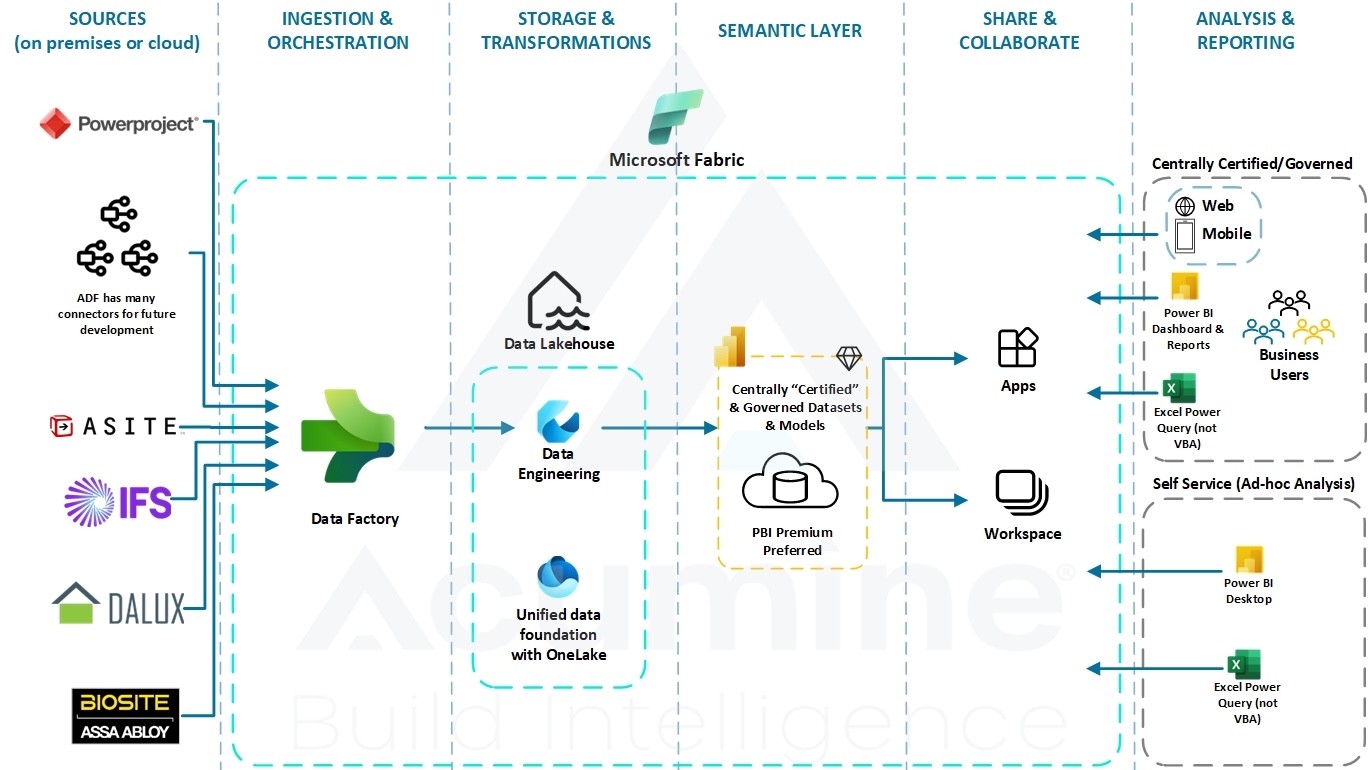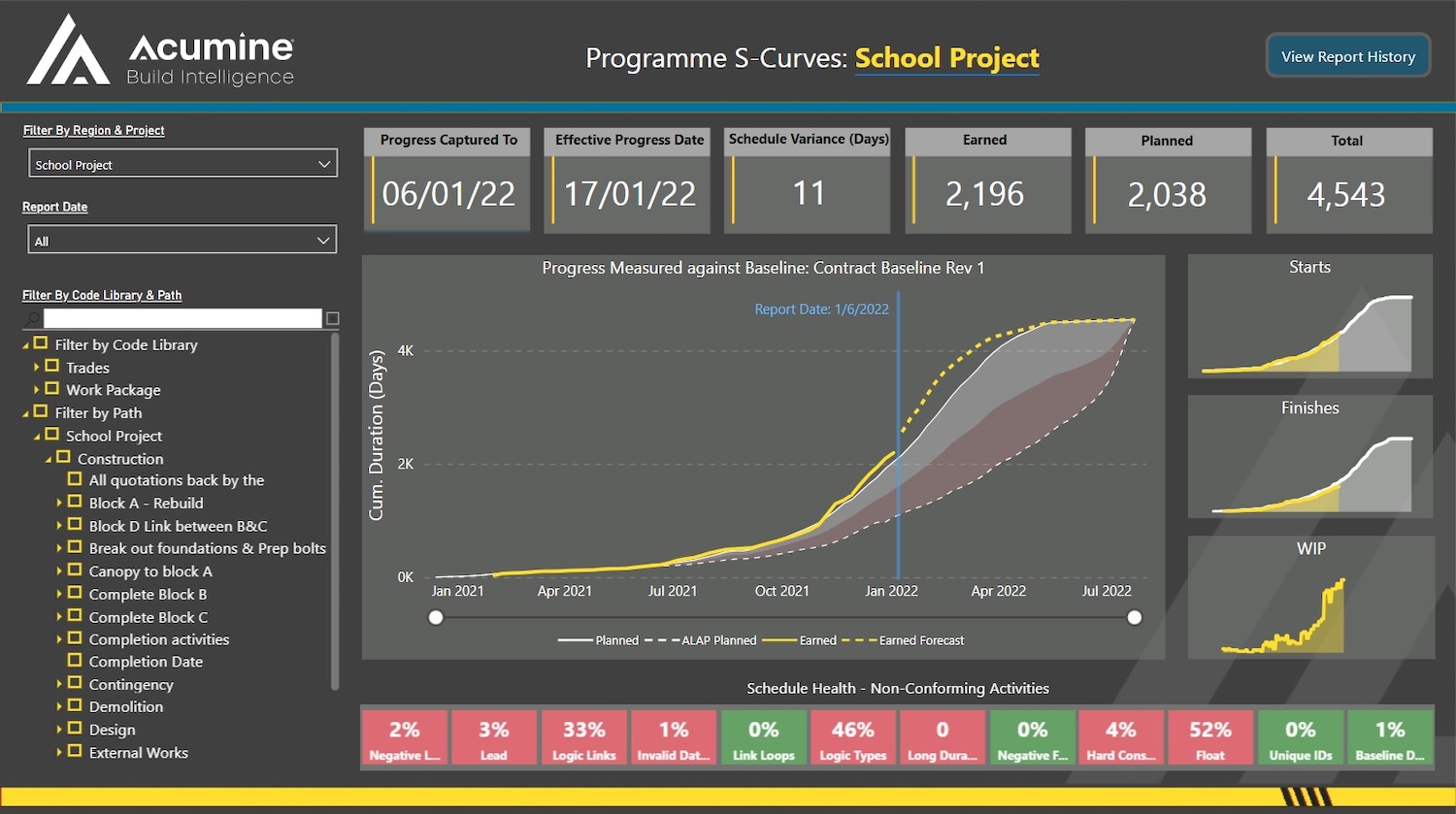
Following BIMplus’s recent interview with Thomas Flannery, head of digital construction at McLaren Construction, here Acumine director Daniel Maddocks describes how the consultancy helped to deliver the contractor’s vision of data-driven construction.
McLaren initiated a strategic engagement with Acumine to further enhance its operational framework. Recognising the evolving landscape of the construction industry, the contractor aimed to exploit the use of advanced data analytics to achieve several key priorities: enhancing operational efficiency, ensuring legislative compliance, reducing risks, and facilitating data sharing across its projects.
This strategic move was designed to support McLaren’s overarching IT and digital strategic objectives, positioning the company to capitalise on data-driven opportunities and sustain its leadership in the industry.
We embarked on a strategic review to align with McLaren’s objectives and operational framework. The review began with a detailed analysis of McLaren’s technology stack, together with its data and reporting processes. We held stakeholder interviews with various departments to gather insights and understand the specific data analytics needs of each function.

“By implementing a Lakehouse architecture, we ensured that McLaren’s data management system is robust, scalable, and conducive to complex analytics and AI-driven insights.”
The consultancy approach was structured to ensure a thorough understanding of McLaren’s operational environment and strategic ambitions. This enabled us to evaluate a range of data analytics solutions, focusing on those capable of enhancing operational efficiency, ensuring compliance, mitigating risks, and facilitating seamless data sharing. The aim was to identify a solution that met McLaren’s immediate needs, and provided a scalable platform for future growth and innovation.
Our strategic review process included a maturity assessment benchmarked against industry peers, a gap analysis to pinpoint areas for improvement, and an exploration of architectural and infrastructure options to support McLaren’s data analytics vision. This holistic approach ensured that the recommended solutions were tailored to McLaren’s requirements.
Platform implementation
In the solution implementation phase, we leveraged Microsoft Fabric’s robust capabilities to develop a future-ready data analytics platform for McLaren. Recognising the advantages of modern data architecture principles, we adopted a Medallion Lakehouse architecture and data mesh principles as the cornerstone. This approach combines the scalability and flexibility of a data lake with the management features of a data warehouse, optimised for the largescale, diverse data ecosystems that are becoming common in the construction sector.
McLaren’s forward-thinking cloud architecture provided the perfect alignment and opportunity to integrate solutions with Microsoft Fabric. This strategic move not only facilitated the seamless incorporation of Microsoft Fabric into McLaren’s existing cloud toolsets, but also positioned the company to leverage Fabric’s capabilities to their fullest extent.
Microsoft Fabric was chosen for its ability to support these advanced architectural paradigms seamlessly. It facilitates the integration of disparate data sources into a cohesive, scalable, and manageable platform. Implementing a Lakehouse architecture ensures McLaren’s data management system is not only robust and scalable, but also conducive to complex analytics and AI-driven insights. This alignment underscores McLaren’s commitment to innovation and positions its IT infrastructure to rapidly adopt and benefit from cutting-edge solutions.

System integrations
In the pivotal phase of system integrations, we integrated four critical systems for McLaren, each designed to enhance visibility, improve operational efficiency, and drive strategic decisions through advanced data analytics.
The first integration focused on FreshService, a decision that directly addressed the needs of the IT department. Microsoft Fabric’s API integration capabilities and its powerful ETL (Extract, Transform, Load) processes enabled us to provide a solution that significantly enhanced the IT director’s oversight of IT service performance across the organisation. This integration exceeded the native reporting capabilities of FreshService, offering a previously inaccessible depth of insight.
This initiative marks a significant step towards fostering a collaborative and data-driven IT culture within McLaren.
The second system integration was with Dalux, a field tool instrumental for McLaren in delivering projects and upholding its quality management processes. We achieved this integration through Microsoft Fabric’s adept handling of data, using its ETL processes to funnel Dalux’s operational data into a structured format suitable for analysis.
“This initiative marks a significant step towards fostering a collaborative and data-driven IT culture within McLaren.”
The construction of a semantic model then allowed for the transformation of this data into actionable insights, showcased through Power BI visualisations.
The result is a clear and dynamic view of McLaren’s project portfolio and quality performance of the supply chain. This will enable McLaren to proactively manage projects and maintain high standards of quality across its operations.
The third and equally transformative integration was with Asite, McLaren’s chosen platform for design and document management processes. This integration mirrored the successes of the previous two, using Microsoft Fabric’s toolset to bridge Asite with McLaren’s data ecosystem. The process involved meticulous API integrations, effective ETL workflows, the creation of a semantic model tailored for design management, and the subsequent visualisation in Power BI.
The adoption of Microsoft Fabric within McLaren’s existing cloud toolsets underscores the forward-thinking nature of McLaren’s IT strategy.
Boosting Asta
The fourth integration focused on Asta PowerProject and Asta Vision, providing McLaren with advanced construction schedule analytics and reporting across its portfolio. Combining our knowledge and Microsoft Fabric’s ETL processes and API integration capabilities, we transformed Asta’s data into comprehensive, actionable insights. This integration will allow McLaren to gain unprecedented visibility into construction schedules and their performance, enabling more effective management and strategic planning.
The advanced analytics and reporting capabilities delivered through this integration highlight McLaren’s commitment to leveraging cutting-edge technology to drive operational excellence.
Through these strategic system integrations, Acumine has not only showcased the extensive capabilities of Microsoft Fabric, but also underscored our commitment to delivering bespoke data analytics solutions. By focusing on API integrations, optimising ETL processes, building detailed semantic models, and creating insightful visualisations in Power BI, we have provided McLaren with the tools necessary to navigate the complexities of the construction industry.
These integrations serve as a testament to the power of strategic data management and the transformative potential of harnessing technology to drive business intelligence and operational excellence
Don’t miss out on BIM and digital construction news: sign up to receive the BIMplus newsletter.











